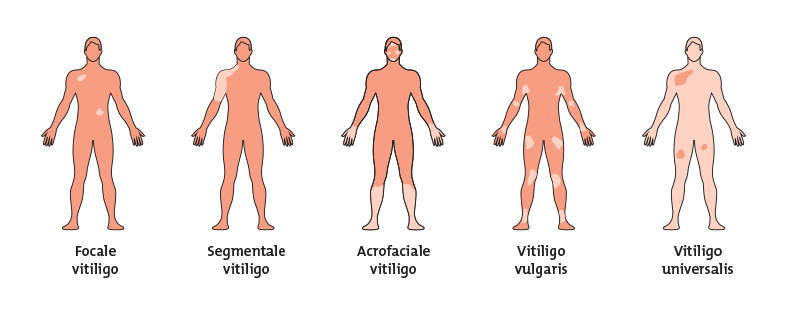An even toned spotless skin is not just a sign of beauty but also of good health. Just like our eyes and nails, our skin bears the symptoms of a vast range of health disorders. Sometimes, white or light colored patches begin to show up on the skin which may be triggered by various factors. If you suddenly notice white patches on your skin, you should get them examined as soon as possible. Many times people misdiagnose these white spots as a sign of Vitiligo. In this article, we try to understand the major causes behind white spots and how to identify if your white patches are Vitiligo or not.
*Information in this article is not an alternative to diagnoses by a qualified physician.

What are white patches and the various causes behind them?
White patches on skin show up as depigmented marks on the surface of the skin and are a source of great distress for many people. However, a timely treatment can greatly help in making them appear less prominent. There are many factors that can cause white patches on the skin and the appearance of these patches differs in each case. White patches are also caused by Vitiligo, a skin condition wherein white patches form on the skin due to improper melanin release within the epidermis. Here we have outlined some other factors that cause white patches to show up on the skin.
Eczema
Eczema or atopic dermatitis is an inflammatory skin disorder in which dry itchy rashes begin to form on skin’s surface. In certain cases, the rashes may leave lighter colored patches on the skin underneath, known as Pityriasis alba.
Yeast Infection
Fungal infections of the skin also cause white or dark colored patches on the skin. Tinea versicolor is a fungal skin infection that triggers the development of white, pink, red or brown colored blotches along with intense itching on the location.
Psoriasis
Psoriasis lesions sometimes leave whitish marks on the skin when they disappear. This is because the scaly lesions that appear in this condition interfere with the melanin release and when they heal and leave white patches.
Sun Spots
Some people develop flat white spots on the skin as a result of overexposure to the sun. These spots form when the skin cells become damaged by ultraviolet exposure and can no longer produce melanin to maintain an even skin color.
VITILIGO
Vitiligo or Leukoderma is a terrible skin condition wherein discolored patches begin to appear on the skin. These patches are usually stark white in color and are a result of damaged melanocytes or improper release of melanin within the skin. Since this skin disorder greatly influences one’s appearance, many people find it hard to deal with the social implications of having this problem and begin to avoid social situations altogether, because of the negative attention they receive from other people.
Types of Vitiligo

Image from vitiligo.jouwweb.nl
Vitiligo does not follow a single pattern and can affect only a certain part of the body or spreads all over the body. Depending on the pattern of the patches, vitiligo has been classified into four categories:
Segmental Vitiligo
This type of vitiligo follows a fixed pattern and affects only a part of a person’s body. Most often it affects the region near the dorsal roots of the spine or the insides of the mouth and nose.
Non – Segmental Vitiligo
This type of vitiligo is the most prevalent. It appears on both sides of the body in a symmetrical pattern on hands, arms, back, knees, eyes, legs, and feet.
Mixed Vitiligo
Mixed vitiligo is a type of vitiligo which exhibits symptoms of both segmental and non-segmental vitiligo. Sometimes segemental vitiligo manifests as mixed vitiligo as well.
Focal Vitiligo
This type of vitiligo remains localized to a specific area and does not spread to other parts of the body.
Causes of Vitiligo
The real reason behind the development of white patches on skin is the loss of pigment in the skin cells. However, the exact cause of this loss of pigment is unknown. Studies have observed some trigger factors that increase the likelihood of developing this skin condition. Autoimmune disease, excessive sun exposure, stress, heredity and imbalances in neurochemicals have been shown to affect the release of melanin within the skin which later develops into vitiligo.
CONCLUSION
Vitiligo is a non-inflammatory skin condition. It does not cause any major harm to a person’s health but it can greatly hamper one’s physical appearance. Some types of vitiligo spread quickly to other body parts. Moreover, treatment of vitiligo becomes difficult if it spreads to other body parts. So we stringly advise you to get your white patches examined by a qualified dermatologist as soon as possible.

Vitiligo is not harmful its just a skin condition. I am having this kin problem since childhood but it doesn’t affect me or my work. It only has an impact on appearance.
Vitiligo is often misunderstood with skin cancer. It’s a totally different skin condition. People must get more and more information before going for any further treatment.
Found it very informative. Suffering from this disorder from a decade. Glad you shared this information with people. Many people still don’t know about this disorder. It’s not a disease just a skin disorder.